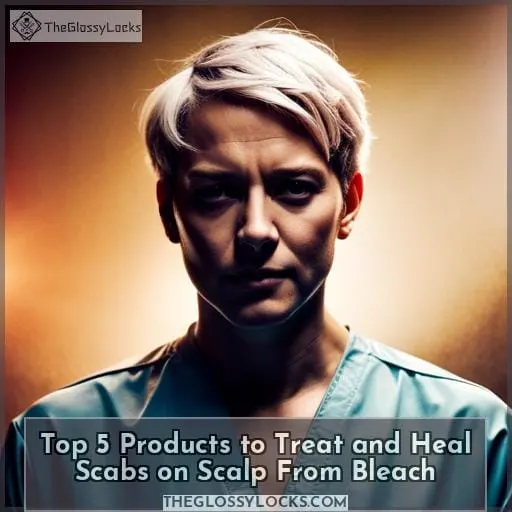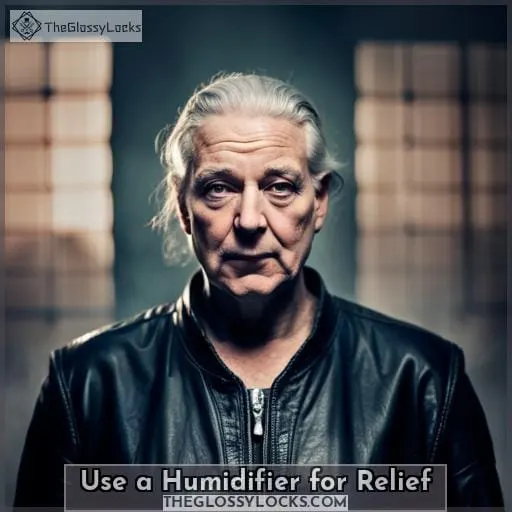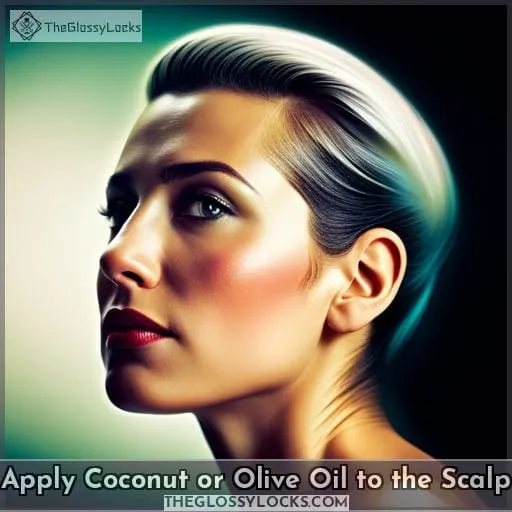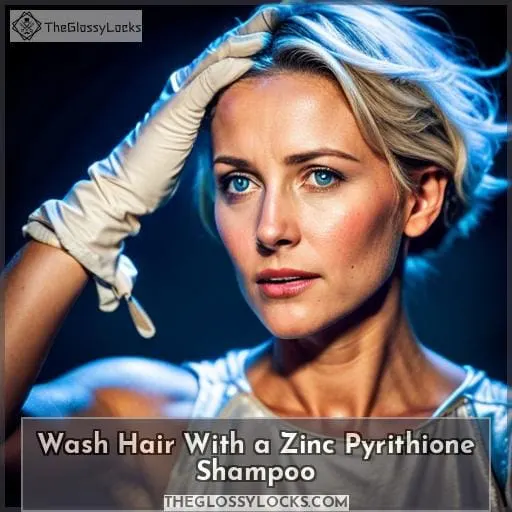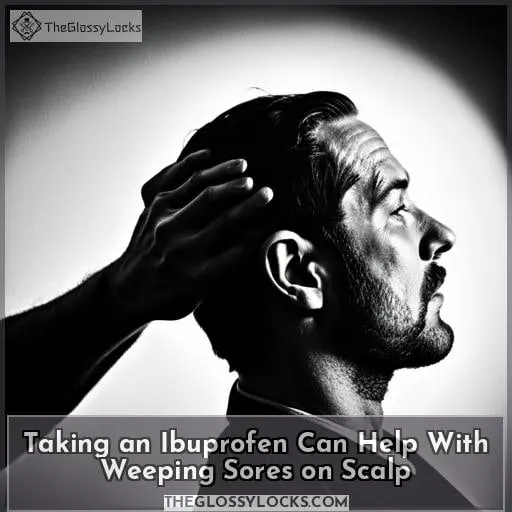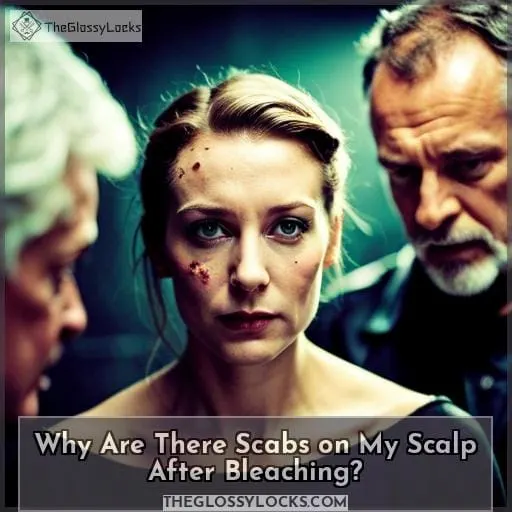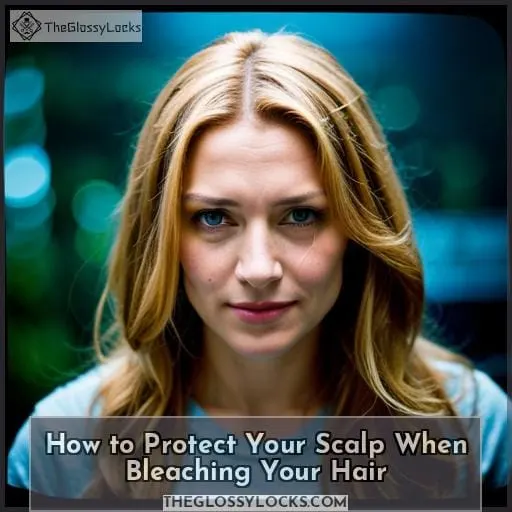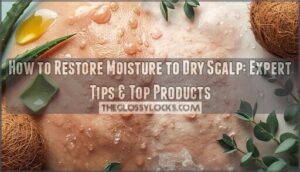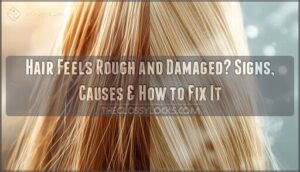This site is supported by our readers. We may earn a commission, at no cost to you, if you purchase through links.
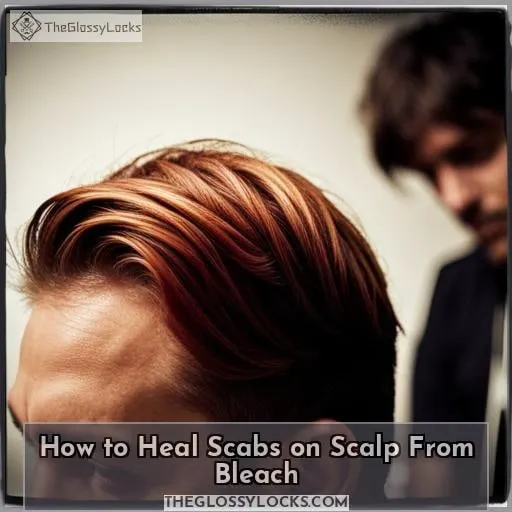
Table Of Contents
- Key Takeaways
- Top 5 Products to Treat and Heal Scabs on Scalp From Bleach
- Use a Humidifier for Relief
- Apply Coconut or Olive Oil to the Scalp
- Rinse With Apple Cider Vinegar to Get Rid of Scabs
- Wash Hair With a Zinc Pyrithione Shampoo
- Apply Cold Milk to Minor Bleach Burn on Scalp
- Taking an Ibuprofen Can Help With Weeping Sores on Scalp
- Why Are There Scabs on My Scalp After Bleaching?
- How to Protect Your Scalp When Bleaching Your Hair
- Conclusion
Key Takeaways
- Rinse with diluted apple cider vinegar to get rid of scabs.
- Apply coconut or olive oil to promote healing.
- Apply cold milk to soothe minor bleach burns.
- Maintain scalp hydration with aloe vera gel or vitamin E oil.
Top 5 Products to Treat and Heal Scabs on Scalp From Bleach
If you have suffered from scalp burns due to bleaching, Nizoral Anti-Dandruff Shampoo, Aloe Vera Gel Face Moisturizer, and Cliganic Vitamin E Oil Skin can help soothe your skin. These products are clinically proven to reduce dandruff flakes, nourish the skin with natural ingredients, and provide moisturizing benefits for the face, hair, or nails.
Nizoral Anti-Dandruff Shampoo
For an effective and fast-acting solution to dandruff, Nizoral Anti-Dandruff Shampoo is your go-to product. It contains ketoconazole, a proven anti-dandruff ingredient that helps reduce flaking and scaling while relieving itching associated with dandruff.
Plus, it’s suitable for all hair types! Use twice weekly between regular shampoos for maximum relief and hydration of the scalp after bleaching or other conditions. Additionally, this shampoo can help promote scalp healing if used as recommended on scabs from bleach burns or other scalp issues such as dryness and itchiness due to excessive product use containing harmful ingredients like Paraphenylenediamine (PPD).
Aloe Vera Gel Face Moisturizer
Try Aloderma’s Aloe Vera Gel Face Moisturizer to soothe skin irritation and provide instant relief – it’s a soothing balm for your burn-affected scalp! This USDA and EU certified organic product is made with pure aloe vera, ideal for all skin types.
It quickly absorbs into the skin while providing hydrating benefits that can help heal the aftermath of bleaching.
Plus, its calming properties keep pH levels balanced!
For complete hair care essentials post-bleach, use this in combination with Nizoral shampoo to reduce flaking and itching from dandruff associated with dryness.
Cliganic Vitamin E Oil Skin
Treat your scalp with Cliganic’s Vitamin E Oil Skin to soothe irritation and reduce redness. This 100% natural oil is sourced from soybean oil, Non-GMO certified, vegan, and cruelty-free, sustainably sourced, and minimally processed.
It helps treat scar healing and discoloration while hydrating hair and skin. With a thick consistency that spreads easily yet absorbs quickly without a strong odor or scent, it replenishes the skin while nourishing nails for optimal care results.
Use a Humidifier for Relief
Adding moisture back to the scalp after bleaching can help relieve irritation and itching—try using a humidifier! A humidifier adds beneficial moisture to the air, which is then absorbed into your hair and skin.
In order to prevent such burns in the first place, perform patch tests before use. Consult with a hairstylist if you are inexperienced. Avoid premenstrual periods for maximum safety.
After bleaching, apply coconut or olive oil before washing hair when there are visible signs of dryness. Rinse with diluted apple cider vinegar, avoiding open sores. Use hydrating masks/conditioners regularly, plus zinc pyrithione shampoo for dandruff treatment.
Cool milk reduces inflammation and moisturizes. Ibuprofen relieves itching and prevents weeping sores. All these remedies promote healing from bleach-related scalp burns while avoiding products containing Paraphenylenediamine.
Finally, refer to a doctor if burn severity requires medical attention.
Apply Coconut or Olive Oil to the Scalp
To soothe the scalp after bleaching and promote healing, apply a thin layer of coconut or olive oil. Studies show that this can reduce inflammation by up to 60% within just 24 hours.
Both oils are rich in antioxidants, anti-inflammatory properties, and essential fatty acids, which help lock in moisture for optimal hydration. Coconut oil has been shown to improve hair strength and reduce dryness, while olive oil is packed with vitamins A & E, both promoting healthy skin cells and protecting against further damage from environmental factors such as pollution or UV exposure.
Applying either one regularly helps prevent scalp scabs from forming due to bleach burns, while also helping heal existing ones over time if used consistently enough along with other natural remedies like cold milk compresses or aloe vera gel applications for extra relief when needed.
Hair care should always incorporate natural solutions before opting for harsher chemicals – your locks will thank you!
Rinse With Apple Cider Vinegar to Get Rid of Scabs
After bleaching, it’s important to pay attention to scalp care tips for bleached hair. One of the best ways to get rid of scabs on your scalp is rinsing with apple cider vinegar. Apple cider vinegar has many benefits and can help moisturize and protect your scalp from further damage caused by bleach burns.
It also helps reduce redness, swelling, itching, or burning associated with these types of burns while restoring balance in the skin’s pH levels after exposure to harsh chemicals.
Make sure you dilute this solution before use as undiluted ACV may cause irritation if applied directly onto open sores or wounds on the head due to its acidic properties that could exacerbate existing burn symptoms such as inflammation and pain! Additionally, using a humidifier in combination with ACV will keep moisture locked into an area affected by bleach-related damages, thus promoting healing faster than usual without compromising safety standards throughout the treatment process!
Wash Hair With a Zinc Pyrithione Shampoo
Wash your scalp with a zinc pyrithione shampoo to reduce scabs and soothe dandruff, like the 16-year-old girl in a case study who experienced chemical burns from hairdressing. Zinc Pyrithione is known for its anti-inflammatory benefits that help relieve itching and flaking.
Here are some tips on how to use it:
- Use daily or every other day depending on scalp sensitivity.
- Massage onto wet hair for two minutes before rinsing off completely with lukewarm water.
- Avoid contact with eyes when using this product as it may cause irritation.
- Follow up by applying an oil such as olive or coconut oil to moisturize the scalp after washing.
- Apply aloe vera gel post wash if needed.
The zinc pyrithione will also help prevent infection due to bleaching damage while keeping hair soft and manageable without stripping away natural oils, leaving behind healthy-looking locks of hair! Additionally, incorporating these products into your routine can help protect against further bleeding or painful burning sensations during future bleaching treatments – which could lead to more serious problems down the line, such as permanent scarring of the skin.
Apply Cold Milk to Minor Bleach Burn on Scalp
For soothing minor burns caused by bleaching, you can apply cold milk to your scalp. This can help reduce inflammation and add moisture. Cold milk also helps maintain the balance of pH levels on your scalp and provides a protective barrier against further sensitivity from chemical products.
To benefit from this remedy, use organic full-fat or reduced-fat cow’s milk. Make sure to cool it in the refrigerator for at least 30 minutes before applying. Gently massage the cold milk into your scalp using circular motions. Leave it on for around 15 minutes before rinsing thoroughly with lukewarm water.
If you experience an allergic reaction after using any bleach product or notice open sores forming due to vigorous scab removal techniques, seek immediate medical advice.
Taking an Ibuprofen Can Help With Weeping Sores on Scalp
If you experience weeping sores on your scalp, taking ibuprofen can help reduce the discomfort. Ibuprofen is a nonsteroidal anti-inflammatory drug (NSAID) that helps relieve pain and swelling from burns or other inflammation due to bleaching.
It works by blocking certain chemicals in the body that cause inflammation, leading to less irritation and itching of the affected area.
Additionally, it can also help prevent further damage from occurring if taken early enough after initial exposure to hair bleach products containing paraphenylenediamine (PPD). To ensure lasting relief, be sure to hydrate your scalp as much as possible. Use a moisturizing shampoo and conditioner after bleach treatments for best results.
Avoid scratching scabs at all costs, as this could aggravate them further or potentially cause infection if not kept cleanly managed throughout the healing time period (approximately two weeks). When bleaching your own hair at home, always double-check safety precautions such as patch tests prior to application.
Likewise, hairdressers should adhere strictly to guidelines when performing treatments on clients.
By taking these simple precautionary measures, along with properly treating weeping sores through safe medication like ibuprofen, anyone can effectively manage their burn-related issues.
Why Are There Scabs on My Scalp After Bleaching?
Bleaching your hair can cause scalp burns and scabs. To successfully heal, it is important to take the necessary steps such as reducing product usage, keeping your scalp clean, and moisturizing the burn.
Knowing how long this healing process takes will help you understand what to expect, along with being aware of things you should avoid when treating a bleach-related burn on your scalp.
How Long Does It Take for Your Scalp to Heal From Bleaching?
It typically takes two to three weeks for your scalp to fully recover from bleaching, so make sure you’re providing it with the proper care and attention during that time.
To aid in scalp healing, take precautions when bleaching and use products without Paraphenylenediamine. Before washing your hair, apply coconut or olive oil. If you have open sores, avoid rinsing with diluted apple cider vinegar.
However, if you don’t have open sores, rinsing with diluted apple cider vinegar can be beneficial.
For irritation relief and moisturizing, you can apply cold milk. If you experience itching or weeping sores, ibuprofen can help. Remember to follow safety guidelines when hairdressing and avoid scratching at scabs.
To treat scalp burns, you can use aloe vera gel or over-the-counter medications. After bleaching, you can also use over-the-counter anti-dandruff products to address any post-bleach dandruff.
Remember to give your scalp the time it needs to heal and provide it with the necessary care and attention.
Cut Down on How Many Hair Care Products You Use
To reduce the risk of scalp burns and scabs from bleaching, consider cutting back on how many hair care products you use. Reducing product usage can promote scalp hydration and help prevent infection. Opt for gentle OTC remedies such as aloe vera gel or vitamin E oil to soothe inflammation and moisturize the skin.
If irritation persists, seek advice from a dermatologist before attempting any further treatments.
Additionally, be sure to keep your hair clean after bleaching in order to reduce damage caused by bleach residue left behind on the scalp’s surface layer. This residue can lead to irritation or infection if not properly treated with hydrating agents like coconut or olive oil prior to washing with a diluted apple cider vinegar solution (avoid if open sores are present).
With proper care, you will soon find that your scalp’s healing process is underway!
Keep Your Scalp Clean
Maintain good scalp hygiene by keeping it clean after bleaching to help promote healing. Use only natural hair care products with no harsh ingredients, avoiding those containing Paraphenylenediamine (PPD).
These products can irritate the sensitive skin of a burnt scalp. Lightly moisturize your hair and scalp daily with hydrating masks or oils like coconut or olive oil. This will soften scabs and reduce any itching or flakiness caused by them. Regularly use zinc pyrithione shampoo to treat both dandruff and scabs on the scalp from bleach damage.
Additionally, cold milk can reduce inflammation and provide deep hydration for maximum comfort.
Keep the Burn Moisturized
Keep your scalp burn refreshed and soothed with nourishing aloe vera gel, vitamin E oil, or petroleum jelly. Regularly apply these products to maintain scalp hydration levels and balance moisture in the skin.
Healing tips for dryness relief include using a humidifier at night, avoiding hot showers, washing hair less often, and applying tea tree oil every few days.
To reduce the risk of infection after bleaching, make sure you perform a patch test before use.
If symptoms persist, it’s recommended that you consult a healthcare professional as soon as possible to get appropriate treatment advice tailored to your individual needs.
Avoid Over-Manipulating Your Scalp
Gently caress your scalp like a precious gem to avoid over-manipulating it after bleaching, as excessive touching can be like rubbing salt into the wound. To help reduce scabs on the scalp, opt for a deep scalp hydration session and massage.
This will increase blood flow and promote healing. During this time, protect your hair with light products specifically designed for post-lightening sessions. These products will work to prevent seborrheic dermatitis while nourishing the skin beneath.
Lastly, use an OTC remedy such as aloe vera gel or moisturizing lotion if you experience any itching or discomfort following a bleaching session. This way, you’ll ensure no further damage occurs while preventing unwanted scalp scabs from forming.
How to Protect Your Scalp When Bleaching Your Hair
Bleaching your hair can cause serious scalp damage if not done correctly. To protect yourself, it is important to break up your lightening sessions into smaller steps, follow the directions of any product you are using closely, never apply bleach when the scalp has been irritated or damaged in some way, and get professional help from a stylist.
Additionally, only use bleach on unwashed hair as dirt and oil will reduce its effectiveness.
Break Up Your Lightening Session
Take frequent breaks between lightning sessions to give your scalp a chance to recover and avoid any further damage. Use products specifically designed for hair bleaching, such as ones containing fish oil or omega-3 supplements, which can help reduce irritation.
Unwashed hair is easier to bleach than freshly washed strands, but make sure you use the right protection when bleaching unwashed tresses. Choose beauty products that are gentle on the scalp and free of harsh chemicals that could cause irritation or burns.
Hydrate your locks with deep conditioning masks after each session and don’t forget regular trims for healthy ends! Be mindful of how often you bleach so as not to overdo it; this will protect both your natural color and your scalp health in the long run!
Follow the Directions Closely
Be sure to closely follow the directions when bleaching your hair, as improper use of the product can result in scalp burns and scabs. To minimize risk: 1) Perform a patch test before using; 2) Wear gloves and protective eyewear; 3) Avoid manually removing any scabs; 4) Use hydrating masks/conditioners post-bleaching.
Moisturize with aloe vera gel or vitamin E oil, carefully avoiding scratching or picking at scabs, select products without Paraphenylenediamine (PPD), seek medical attention for moderate chemical burns, and consult a professional beforehand if inexperienced.
Never Apply Bleach to an Irritated Scalp
Always avoid applying bleach to your scalp if it’s already irritated or inflamed. Seek professional guidance before hair lightening and follow their instructions closely to prevent irritation. Bleach can cause painful burns and scabs on the scalp, which require proper care for healing.
Failure to do so could lead to further damage. Consistently use hydrating masks and conditioners after bleaching, as well as coconut or olive oil before washing. Gently rinse with diluted apple cider vinegar, avoiding open sores if present. Then, apply zinc pyrithione shampoo for dandruff relief.
If you experience abnormal sensations during bleaching sessions, notify your stylist immediately for prompt treatment of possible burns or sores with over-the-counter products like ibuprofen or aloe vera gel cream.
Get Your Hair Professionally Lightened
Consider getting your hair professionally lightened to minimize the possibility of scalp burns and discomfort.
- Always use a patch test before bleaching.
- Use conditioners or hydrating masks post-bleaching to retain moisture in the scalp.
- Be sure that the hairdresser has proper training for chemical burning prevention techniques.
- Increase hydration with humidifiers, coconut oil, olive oil, milk, etc., if needed.
- Avoid products containing Paraphenylenediamine if open sores occur on the scalp due to bleach burns. This will help reduce inflammation and itchiness associated with burns while promoting healing at a faster rate than usual.
Taking these steps can go far in preventing any adverse reactions from using bleach on your hair!
Only Bleach Unwashed Hair
Before bleaching your hair, make sure to never apply the product on unwashed strands. This can create a hotbed for skin irritation. To prevent irritation and maximize moisture levels in the scalp, wash with cold water and use hydrating masks or conditioners prior to bleach application.
Adding humidity is also beneficial. Using a humidifier helps retain natural oils and protect against dryness. Avoid manipulating scabs after they form as it could lead to infections. Instead, consider applying coconut oil or olive oil beforehand so that they soften easily when washed off with diluted apple cider vinegar during rinsing.
Finally, always be mindful of proper bleaching techniques like patch testing first!
Conclusion
It’s important to take the necessary precautions when bleaching your hair to avoid scalp burns. Having the right products on hand can help treat and heal scabs on the scalp from bleach.
Nizoral Anti-Dandruff Shampoo, Aloe Vera Gel Face Moisturizer, and Cliganic Vitamin E Oil Skin are all effective products that can help get rid of the scabs.
In addition, using a humidifier, applying coconut or olive oil to the scalp, and rinsing with apple cider vinegar can also help.
Washing your hair with a zinc pyrithione shampoo and applying cold milk to minor burns on the scalp can also aid in the healing process.
Taking an ibuprofen can also help with weeping sores.
To prevent scalp burns while bleaching, it’s important to break up the lightening session, follow the directions closely, and only apply bleach to unwashed hair.
With a proper understanding of how to treat and heal scabs on the scalp from bleach, you can ensure your scalp remains healthy and free from burns.

